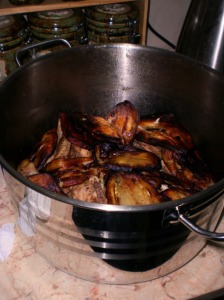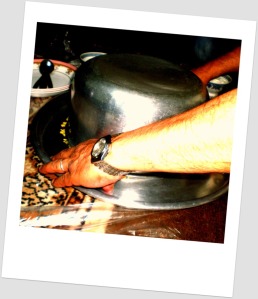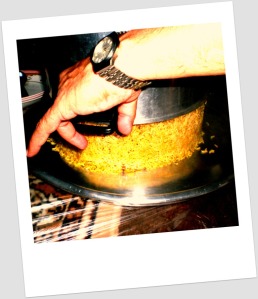“Upside-Down”: Chicken Ma’loubeh with Eggplant
You knew this was coming, didn’t you?
Of course. If there is a dish of which absolutely every Palestinian is fond, it would be ma’loubeh. Ma’loubeh is like roast beef and mashed potatoes for Americans. Or chicken noodle soup. Or spaghetti. My family is from the Palestinian city of Khalil (known as Hebron in English), and ma’loubeh is definitely a favorite among Khalilis. It is one of about four possible dishes you will be served if you are invited to dinner by a Khalili family, especially in Ramadan (a “3azoomeh”). Ma’loubeh is easy, relatively cheap to make, and everyone likes it. Even if you don’t like eggplant or cauliflower, you can still eat the rice and meat.
The name means “Upside-down;” perfectly fitting, because the dish is literally constructed upside down and then flipped upon serving! Q-l-b is the verb root meaning “to flip,” and m-q-l-ou-b-ah is that which is flipped :)
Also pronounced maqloubeh, magloubeh, makloubeh – depending on which region of Palestine you’re from -, ma’loubeh is basically rice, meat, and a vegetable, layered in a pot then cooked. The rice can be either Egyptian or American short grain, the meat can be chicken, beef or lamb, and the vegetable can be either cauliflower or eggplant (although I have even seen some people use potatoes, tomatoes, peas, and carrots!). The best part of this dish is the “flipping” of it; you pull off the pot to reveal a steaming hot layered “cake” of delicious, spiced rice, tender chicken, and succulent eggplant.
Today I’d like to post my aunt Hala’s recipe for the most delicious chicken ma’loubeh with eggplant you’ll ever eat :) She is known in the family for her excellent ma’loubeh.
Tip #1: If you live in the Middle East, cauliflower is known to be tastier in the winter. It is softer, more flavorful, and fries well. Ma’loubeh with cauliflower always tastes better in the winter :)
Tip #2: The eggplant used in ma’loubeh is fried. The best type of eggplant for frying is the short, “fat”, round, purple eggplant; it does not absorb much oil in frying. If you can only find the longer, oval-shaped eggplant (which is all I could ever find back in Minnesota), be warned that you’re going to be using a LOT of oil. The stuff soaks up the grease like a sponge.
Ingredients:
1 chicken, washed and quartered – best way to wash a chicken explained here
3 large eggplants (add more if you like!)
1 kilogram of American short grain rice, washed and soaked (if using Egyptian rice, do not soak!)
Spices: 2 tablespoons each of allspice, black pepper, ground ginger, ground coriander and 1 tablespoon each of cinnamon, cardamom, turmeric, yellow curry powder, and half a tablespoon of cumin
Salt to taste
Vegetable oil for frying
Method:
First, get the chicken cooking because this is what takes the most time. Put your washed pieces of chicken into a pot, and add enough water to cover. Add three quarters of the spices to the water, stir, then cover. Let the chicken boil for about half an hour, or until just cooked. When it’s done, take out the chicken and set aside. Add the remaining quarter of the spices to this broth, or put in even more of each spice if you like extra flavor! (I do.) Set this spiced broth aside.
(Tip #3: If you are hesitant about your “chicken cleaning” skills or the quality of the chicken you are using, try this tip. It will make for an even “cleaner” chicken experience if you let the chicken boil in plain water (no spices) for a few minutes. You will notice that a grayish foam will start to form on the surface of the water. Scoop that off and dump it! We call this foam “zafar.” When the foam no longer continues to form (or it turns white instead of gray), you can add the spices, cover the pot, and let the chicken cook. )
Next, prepare your eggplant for frying! Wash your eggplant, then cut off the green stem. You can peel the eggplant if you don’t like the skin, or think it’s too tough (my aunt does). Cut off any brown, hard spots on the purple skin if leaving the skin on. Slice the eggplant into slices of medium thickness. Put the slices in a colander in the sink, then sprinkle them generously with salt. Leave them to “salt” for 20 minutes. This process gets rid of any bitter juices in the eggplant, and also ensures that they don’t absorb much oil when fried.
After they have salted for twenty minutes, rinse the slices of eggplant, and fry them on each side in hot vegetable oil until golden brown. Don’t crowd them in your fryer!
Now start layering!
Layer 1: In a large pot, put a few spoonfuls of vegetable oil, then take your boiled chicken pieces and layer them on the bottom.
Layer 2: On top of the chicken, layer your fried eggplant.
Layer 3: On top of the eggplant, layer the washed and soaked American rice evenly (or just washed, if using Egyptian).
Finally, here is the tricky part: you want to pour enough of the spiced chicken broth you’d set aside into the pot of ma’loubeh to just barely cover the rice. As you pour the broth in, the rice you’d layered evenly in the pot might get unsettled and form little hills; use a spoon to even it all out.
Cover the pot of ma’loubeh and let it cook on high heat until the broth starts to boil. Let it boil for two minutes on high heat, then turn your stove down to the lowest heat setting. Leave it to cook – covered – for about 20 minutes. Check on it: if it looks terribly dry, add some more broth (or water if you don’t have any broth left). Use a fork to turn over the grains of rice on the top; they will be the least cooked, so you want to mix the layer of rice a little bit just so the topmost grains can get their fair share of cooking!
The ma’loubeh shouldn’t take more than 35-40 minutes of cooking time, max. Check on it throughout; fork through the layer of rice, and whenever the rice is done, your dish is complete.
Flipping!: You’ll need to be very careful with this step. Uncover the pot of ma’loubeh and place a large, round serving dish face down on it. With both hands, grab the handles of your pot and the edges of the serving dish, and flip the entire thing upside down onto a table in front of you. It would be good to have someone standing nearby to help grab in case you feel like the pot or serving dish is slipping! My father or uncles usually get called in to the kitchen to take care of this step. Tap the upside down pot with a spoon to try and make sure the rice doesn’t stick inside, so you get a nice clean “cake.” After a few seconds, pull the pot off slowly! The result is indescribable. Dig in!

The flipped ma’loubeh! It’s still steaming hot. We had already dug into it before I could even take the picture. Notice the layers you create: rice on the bottom, eggplant, then chicken. We serve it family-style and all eat off the one communal serving dish. The aluminum dish in the photo is called a “sidir.”
Traditional sides to serve with ma’loubeh: fresh yogurt and salad, like fettoush.
I have some pictures of a chicken cauliflower ma’loubeh we made a few months ago when my friend Cat was visiting me here in Jordan. These Ma’loubeh Memories are for her :)

Ta-da! Success! The thing on top is a round piece of metal that you put in the bottom of your pot before starting to layer the various items in. This prevents whatever is on the bottom from burning and sticking. I have no idea if it has an actual name in English.
Tags: 3azoomeh food, beef, cauliflower, chicken, cooking tips, eggplant, Egyptian rice, foam, fried vegetables, frying, lamb, layer, Palestinian, rice, tips, traditional, traditional Palestinian cuisine, zafar
11 responses to ““Upside-Down”: Chicken Ma’loubeh with Eggplant”
Trackbacks / Pingbacks
- Recipe Corner: Annie Chekijian's Ma'loubeh – Upside Down Pilaf - Trentinoinrx - July 28, 2022
- Уголок рецептов: Ma’loubeh от Энни Чекиджян – обратный рис – Tenerifedoctors - July 28, 2022
- Recipe Nook: Annie Chekijian’s Ma’loubeh – Upside Down Pilaf - News Quack - July 28, 2022
- Recipe Corner: Annie Chekijian’s Ma’loubeh – Upside Down Pilaf - - July 28, 2022
- Recipe Corner: Annie Chekijian’s Ma’loubeh – Upside Down Pilaf – Tricks and Tips - July 28, 2022
- Recipe Corner: Annie Chekijian’s Ma’loubeh – Upside Down Pilaf – Tricks and Tips - July 28, 2022
- Recepthoek: Annie Chekijian’s Ma’loubeh – Ondersteboven Pilaf – Tandepolicy - July 28, 2022
- Γωνία συνταγής: Ma'loubeh της Annie Chekijian – Ανάποδα πιλάφι - small business - July 28, 2022
- Kącik Przepisów: Ma'loubeh Annie Chekijian – Upside Down Pilaf - przepisy kulinarne jedzenie - July 29, 2022







A family favorite with beef, eggplant and cauliflower, We made it for the rehearsal dinners for both of our married children and one of our daughter’s graduation party. Guests keep wondering when we are having another party!
It definitely makes an excellent party dish. I’ve never had eggplant and cauliflower together; I really need to try that out asap!